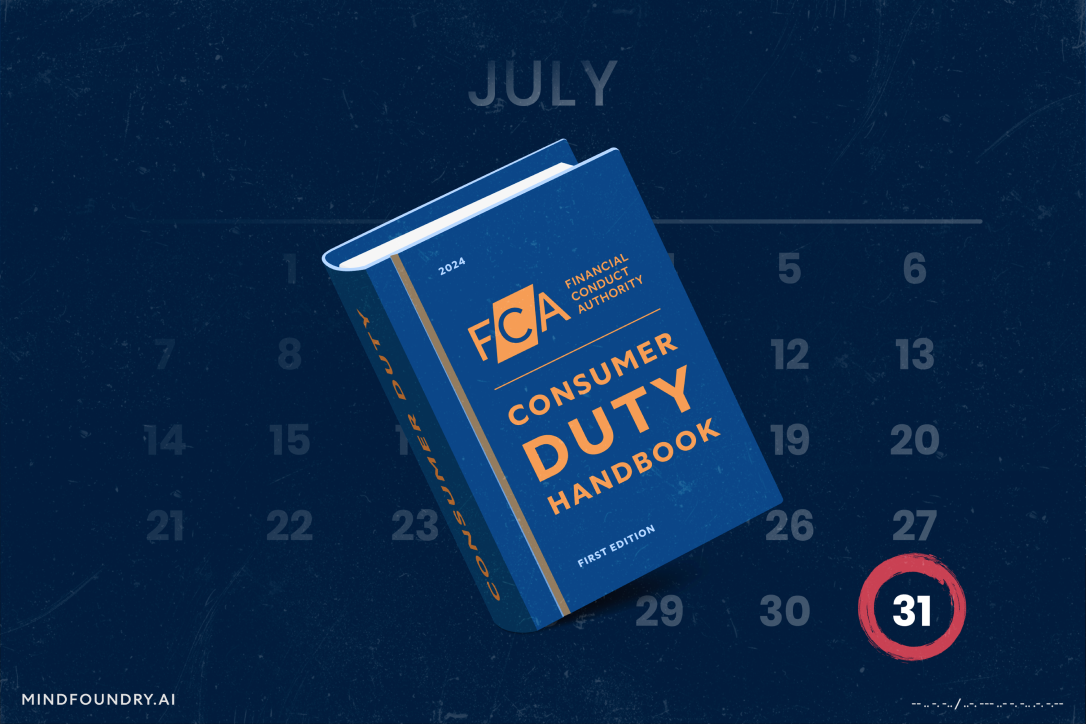AI, Insurance, and the UN SDGs: Building a Sustainable Future
Mind Foundry has been working alongside Aioi Nissay Dowa Insurance and the Aioi R&D Lab - Oxford to create AI-powered insurance solutions whose...
6 min read
Mind Foundry
:
May 2, 2024 11:09:01 AM

On July 31st 2024, the Consumer Duty came into effect for both open and closed products, with far-reaching implications for any organisation offering a financial service or product in the UK. This includes the insurance industry, and insurers must adjust their business to accommodate a changing regulatory landscape. Keep reading to learn about the Consumer Duty, what it contains, and how it affects organisations in the insurance industry, particularly those deploying AI.
What is the Consumer Duty, and why has it come about?
The Consumer Duty is a new set of rules and guidance brought in and overseen by the Financial Conduct Authority (FCA), a financial regulatory body that operates independently of the UK Government. In recent years, there have been concerns amongst regulators, consumer groups, and MPs about the actions of some organisations and their effects on their customers. This has led Parliament to require the FCA to adjust its guidance to hold firms to greater accountability. As of July 31st, insurers must actively seek to deliver positive outcomes, offer services that represent fair value, and be able to clearly explain to regulators how they’re doing this. Insurers must pay particular attention to how they use AI for things like pricing, as the impact of their decisions and actions will be heavily scrutinised.

What does the Consumer Duty say?
The Duty is comprised of three components. The Consumer Principle reflects the overall standard of behaviour the FCA wants from firms, the cross-cutting rules set out in greater detail how firms should act to deliver good outcomes for customers, and the four outcomes represent the key elements of the firm-consumer relationship that organisations should focus on to comply with the Consumer Duty.
The Consumer Principle
This states, "A firm must act to deliver good outcomes for retail customers”. It prompts businesses to take a proactive approach and ask themselves questions like:
Insurers of all sizes must ask themselves these questions constantly during every stage of operations and always challenge themselves to meet the expectations of fair value and positive customer outcomes.
The ‘cross-cutting rules’
These articulate in greater detail the standards of conduct that the FCA expects under the Consumer Principle. These rules require firms to:
These three rules are all interlinked, and compliance with one will help with the rest. Firms acting in good faith will create an environment enabling customers to pursue their financial goals and make decisions in their interests. Conversely, a firm acting in bad faith is more likely to cause harm to customers whilst restricting their ability to pursue its financial objectives. Organisations must act in a way that satisfies all three of these rules.
Insurance Example:
Let's take a look at how this might look in insurance pricing. An insurer can act in good faith by proactively implementing explainable AI in its pricing models. Explainable pricing models mean an insurer can communicate to customers why their policy or premium price might differ from what they expected. Customers can more effectively pursue their financial objectives if they understand the relevant factors affecting their prices. The subsequent uptick in customer satisfaction is another valuable feature of AI explainability. By replacing confusion and frustration with explainability and clarity, customers will trust their insurer more, and customer satisfaction scores will increase. Without explainable AI, insurers won’t be able to communicate their decisions effectively to customers, and this will lead to reduced customer satisfaction scores from frustrated customers who won’t understand why their prices have gone up. Ultimately, this puts insurers at risk of failing to provide fair value, clear communication, and customer support. This is why models that aren’t explainable, like black box models or those with unreliable explainability from third-party systems, are increasingly risky and problematic in use cases like insurance pricing and why techniques that can increase their explainability are so valuable.

The ‘four outcomes’
are informed and supported by the cross-cutting rules. They set clear expectations for how firms should conduct themselves in four areas that represent key elements of the firm-consumer relationship:
Once again, none of these four outcomes should be viewed in isolation. They are interconnected with the other aspects of Duty. For example, communicating clearly and providing effective consumer support (Outcome #4) is essential for firms to enable and support customers to pursue their financial objectives (Cross-cutting Rule #3) and demonstrates a desire to deliver good outcomes for retail clients (Consumer Principle).
Insurance Example:
Insurers use AI extensively in their pricing functions to help them offer fast and accurate quotes to new and existing customers. Implementing proper AI governance gives the assurance that an insurer’s pricing models are:
Many insurers are using hundreds of AI models. Without governance, these models risk:
What does the Consumer Duty require insurers to do?
There are four drivers for firms looking to become compliant with the Consumer Duty, and insurers must ensure that acting to deliver good outcomes is central to each.
Purpose – an insurer’s purpose should be consistent with the Duty, and its staff should understand the firm’s purpose of delivering good customer outcomes.
Leadership – insurance leaders should be competent and accountable and demonstrate commitment to delivering good customer outcomes.
People – delivering good customer outcomes should be reflected in how people are trained, managed, and rewarded.
Governance – an insurer’s controls and key processes should be set up to enable the firm to identify where they’re not delivering good outcomes for their customers. All insurers should have a strategy to understand and tackle root causes and manage and mitigate poor outcomes.
The Duty requires insurers to constantly assess, test, understand, and be able to evidence the outcomes their customers are receiving. Without this, they will not know that their products and services work as they and their customers expect. Specifically, insurers will need to:
Insurance Example:
AI governance can give insurers the necessary tools to continuously assess, test, understand, and evidence the workings of all their models against the latest regulations or within the ethical framework in which they operate. If a customer complains that their insurance premiums have increased and they believe this was due to using discriminatory factors, an AI governance platform like Mind Foundry Motion enables insurers to validate whether this is the case and take the necessary action if it is found to be true. It can also enable insurers to identify alternative models with the same performance levels but without associated risks like discrimination or regulatory noncompliance. Without this, insurers will always be exposed to the potentially significant damage that ineffectively governed AI can cause.
How will the Consumer Duty be enforced?
A key metric that the FCA will use to judge insurers’ compliance will be customer complaints to the Financial Ombudsman Service (FOS). These complaints might indicate that customers don’t feel they are being treated fairly and could indicate to the FCA that the insurer is not complying with the Consumer Duty. Insurers should be mindful that the FOS has said it will work closely with the FCA to ensure alignment and that the Duty is rolled out effectively.
The FCA’s response to non-compliance “will be proportionate to the harm – or risk of harm - to consumers, prioritising the most serious breaches and acting swiftly and assertively.” Insurers who fail to comply can expect “robust action", including investigations, interventions, and potential disciplinary sanctions, like financial penalties. Insurers that don’t deliver positive outcomes for their customers under the Duty will also damage their reputation. Insurance is an industry where margins are often tight, and reputations are essential for winning and retaining customers. For any insurer, reputational damage inevitably comes with an added financial toll.
The consequences of failing to provide good customer outcomes mean insurers have to rethink their governance processes, especially those around AI. Pricing and data science teams would not usually expect to be on the front lines of regulatory compliance. However, with AI regulation worldwide becoming clearer and stricter, established insurers are deploying pricing governance teams to prevent their pricing models from hindering compliance efforts. Against this backdrop, an automated and scalable governance platform offers insurers a tool built specifically to future-proof their AI adoption and stay on the right side of regulators.
Compliance is a constant process, not a single target.
The Consumer Duty clearly states that organisations must constantly and rigorously self-assess and work to improve their operations to deliver better customer outcomes. In highly competitive, customer-centric industries like insurance, compliance is a continuous process rather than a “one and done”. An insurer’s tools and processes must be constantly assessed, and areas of weakness or improvement opportunities should be identified and addressed as and when they arise. As AI becomes increasingly prevalent in insurance and the number of models in an insurer’s portfolio scales, platforms providing effective AI governance have become a fundamental necessity. For all organisations that fall under the jurisdiction of the Consumer Duty, the time for talking is over, and the time for action has arrived.
Enjoyed this blog? Read our 7 Steps for Scaling AI Governance in Pricing

Mind Foundry has been working alongside Aioi Nissay Dowa Insurance and the Aioi R&D Lab - Oxford to create AI-powered insurance solutions whose...

Local authorities need to support their funding requests with high-quality data. The problem is that they can't obtain this data at the required...

The UK-USA Technology Prosperity Deal sees overseas organisations pledging £31 billion of investment into UK AI infrastructure. As AI investment...